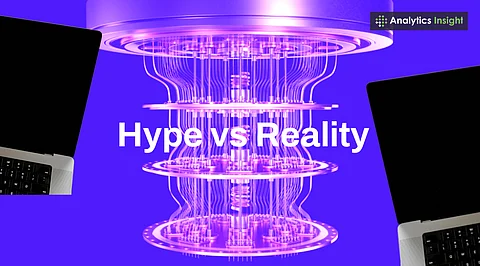

Quantum computing is in its noisy, experimental stage and is powerful for research but still far from replacing classical systems.
Most hype comes from misunderstandings, and quantum supremacy does not mean commercial readiness or broad industry impact yet.
The near‑term future is hybrid, with quantum and classical computing working together while focusing on niche, high‑value applications.
For the last decade, quantum computing has been the glittering promise to technology’s crystal ball. It has been termed as the power to break the toughest encryptions, simulate nature with uncanny precision, and solve problems that classical computers would take years to crack. From boardrooms to research labs, the opinions have been resolute: the dawn of a new computing age is near.
The picture is far more grounded as the technology continues to grow. Quantum computing is real, but so are its limits. Although the promise is clear, most breakthroughs that could be called ‘game‑changing’ are still many years or even decades away. This raises the real questions: what is hype, what is fact, and where does the field truly stand today?
The present stage of quantum computing, referred to by physicist John Preskill as the NISQ era(Noisy Intermediate‑Scale Quantum era), is marked by hardware capable of novel computational feats compared to five years ago. However, these systems remain constrained by high error rates, operational fragility, and unpredictable behavior.
Scale and performance: Machines from IBM, Google, and others now boast hundreds of qubits. But raw qubit count doesn’t equal capability. Noise and limited coherence time mean these systems can only run short, shallow algorithms before results become unreliable.
Error rates: Even the best two‑qubit operations fail at rates above 0.1%. That might sound tiny, but in quantum computing, errors snowball rapidly. Without large‑scale error correction, big‑ticket algorithms remain out of reach.
No fault tolerance yet: Running Shor’s algorithm to crack encryption keys would require millions of error‑corrected qubits. We’re still orders of magnitude away.
Bottom line: these are extraordinary research tools, but not yet the industrial workhorses the headlines suggest.
Also Read: Best Quantum Computing Stocks to Buy & Invest Now
The media loves a ‘quantum supremacy’ headline, and it’s easy to see why. Google’s 2019 claim that its Sycamore processor solved a problem in 200 seconds that would take a supercomputer thousands of years grabbed global attention. What’s less glamorous: improved classical algorithms later cut that gap drastically.
Here are some persistent myths worth clearing up:
Quantum processors excel at highly specialized problems such as simulating quantum physics, but for most everyday workloads, classical computing will remain king.
Quantum supremacy is best understood as a milestone in scientific research, not as a ready‑made business opportunity. The experiments that have demonstrated it so far address carefully constructed problems that have little connection to real‑world computational needs.
Shor’s algorithm could break RSA encryption, but that’s a future concern, not today’s crisis. Building a machine capable of it will take decades. In the meantime, post‑quantum cryptography is already being deployed.
Quantum machine learning is still highly experimental. Error rates and data transfer bottlenecks keep it from competing with the raw power of GPUs for mainstream AI tasks. Most current research focuses on hybrid approaches where quantum processors handle niche sub‑tasks while classical hardware manages the bulk of computation.
That’s not to say the field’s potential is overblown. The trick is knowing where and when to expect impact.
Drug discovery and material science: Simulating molecules is painfully slow for classical computers. Quantum devices could eventually crack these problems, unlocking new medicines or superconductors.
Fundamental physics: NISQ systems can probe exotic quantum states that are impossible to model classically, helping expand our basic understanding of the universe.
Optimization: Hybrid algorithms like the Variational Quantum Eigensolver (VQE) and Quantum Approximate Optimization Algorithm (QAOA) could offer incremental gains in logistics, finance, or engineering, if noise can be tamed.
Secure communications: Quantum key distribution (QKD) and quantum randomness generation could bolster security, even before large‑scale quantum computing arrives.
The most practical approach today blends quantum and classical resources. A quantum processor handles a small but hard sub‑problem; classical computers do the heavy lifting. Cloud platforms like IBM Quantum and Amazon Braket are making it easy for researchers and engineers to explore this model without buying a multimillion‑dollar dilution refrigerator. This isn’t about replacing what works; it’s about adding a new tool to the box.
For engineering and business teams, a measured strategy is essential:
Experiment on the cloud: Run test cases, understand constraints, and identify if any problems you face are even a good match for quantum.
Build internal knowledge: Train staff in quantum programming languages and concepts now, so you’re ready when the hardware catches up.
Collaborate: Partner with research groups or industry consortia to share risk and insight.
Invest in R&D, not hype: Fund long‑term projects that build skills and intellectual property, rather than chasing the next ‘supremacy’ press release.
Also Read: How Quantum Computing is Revolutionizing Data Centers’ Future?
Quantum computing will need time, proof, and engineering genius before it reaches the heights we imagine. Some call it a revolution waiting to happen. Others disregard it as a dream that will fade. Right now, it’s a proving ground, a place to explore, experiment, and prepare.
The industries that will benefit most are those willing to stay the course, avoiding the trap of inflated expectations while quietly building the expertise to act when the hardware matures. As the saying in the field goes: the future is quantum, but it’s not here all at once.
